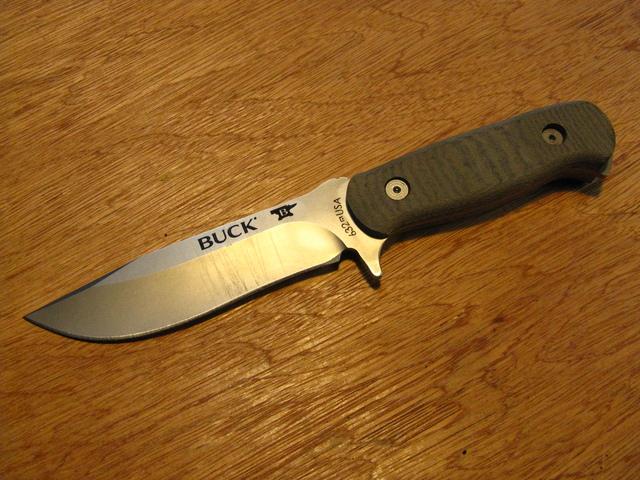- Joined
- Mar 8, 2008
- Messages
- 26,082
The issue with 420HC is usually a matter of how hard it is. If it's run soft it'll be a pain to get a crisp apex on, even though grinding/rough shaping is easy. When run sufficiently hard, it's a breeze to sharpen.
The BladeForums.com 2024 Traditional Knife is ready to order! See this thread for details:
https://www.bladeforums.com/threads/bladeforums-2024-traditional-knife.2003187/
Price is $300 $250 ea (shipped within CONUS). If you live outside the US, I will contact you after your order for extra shipping charges.
Order here: https://www.bladeforums.com/help/2024-traditional/ - Order as many as you like, we have plenty.

I didn't know the chromium in 440C steel is there to form carbides like in D2 steel. I thought in 440C chrome is there for to make it stainless and stays in the solution.The extremely hard-to-sharpen Bucks were 440C and run on the hard side, and many people struggled to sharpen them on Arkansas stones due to the high chromium carbide content
The chromium will first react to form carbides in proportion to the carbon content in the steel, and then the remaining free chromium will contribute to corrosion resistance. 440C has roughly twice the carbon content of 420HC (1-1.2% carbon in 440C vs. ~ 0.5% carbon in 420HC), so a larger portion of the chromium in 440C will first go toward carbide formation with the carbon. Then, whatever free chromium is left will contribute to the stainlessness of the steel. 440C is still relatively corrosion resistant, due to the 16-18% chromium content in the steel (as compared to 13-14% chromium in 420HC). But a significant portion of that chromium will go toward carbides first, in 440C.I didn't know the chromium in 440C steel is there to form carbides like in D2 steel. I thought in 440C chrome is there for to make it stainless and stays in the solution.
The page linked below has an interesting look at that. If you scroll down the page, it shows 3 micrographs of three different steels, comparing (visually) the carbide volume in each of them. It compares a 420-grade steel to 440C and also to AEB-L. It doesn't specify an amount numerically, in terms of how much chromium in each goes to carbide formation. But instead, it clearly illustrates the physical size of the carbides themselves (very large in 440C, much smaller in the 420-grade steel) and also how widely distributed in the steel they are. And quoted below, a description of the three seen in the micrographs:For example, D2 steel has about 12% of Chromium in composition but most goes to form carbides. So, in solution there is only 4 to 6% of Chromium left.
440c has about 17% of Chromium in composition. How much of Chromium goes to form carbides?
"Photo micrographs of 420, 440C, and 19C27 can be seen below. The carbide volume (white/grey particles) is much lower in 420 and the carbides are much smaller, which is because of its low carbon-chromium combination. Because of the low carbide volume and small carbides it has high toughness and ease in sharpening but lower wear resistance than 440 grades or AEB. 440C has a large volume of large carbides giving it high wear resistance but the lowest toughness of the three. AEB is an intermediate grade in terms of carbide volume, toughness, and wear resistance:"
440C is uniquely interesting to me, because there's such a distinct threshold in ease of sharpening between natural stones and pretty much any other synthetic stone. It's very easy to deal with on AlOx, SiC, diamond, etc. But it kind of slams the door on Arkansas stones if one is trying to do any significant grinding, thinning & reshaping of the edge. 440C is classed as a true stainless, presumably meaning around 12% or so of it's 16-18% total chromium content is providing corrosion resistance. That leaves the balance of the chromium available, possibly up to 5% or so, for forming carbides. Not necessarily huge for wear resistance as compared to something like D2, but it's enough to make a big difference on natural stones, as many who've tried it have found out, including myself.Thanks for the link. It will be interesting reading.
I was looking at those two links below. They list 440C as high carbon martensitic stainless steel and D2 as alloy - tool steel so I assumed the content of Cr carbides in 440C is much lower as in D2.
By the way, I fI remember correctly knifesteelnerds also have article about D2 steel.
I wondered why 440C would be hard to sharpen. I use diamond files but using classic stones 440C indeed could be hard to sharpen because of carbides.
https://steelselector.sij.si/steels/PK348.html
https://steelselector.sij.si/steels/SIHARD_2379.html
lol are those scored in marks for your sharpener?My Buck 420-HC blades get short quickly with regular use.View attachment 2333682
I traced the fingers of the sharpening jig onto the blade in order to return the jig to the exact same place. I use a Diamond glass cutter for tracing.lol are those scored in marks for your sharpener?
I think a lot of the struggle with the Buck knives back in the day were also caused by the semi hollow grind they put on the blades.It was hollowed out above the edge bevel but leaving the edge fairly thick.
I know that a convex edge is more desirable, but I ain't got time for that either.
The new WSPAPro is fast,easy and repeatable down to 0.25°, which is pretty freaking accurate.
I just wish they would make one designed and built for great big thick choppers, which is at least 70% of my collection. Maybe next year ?
